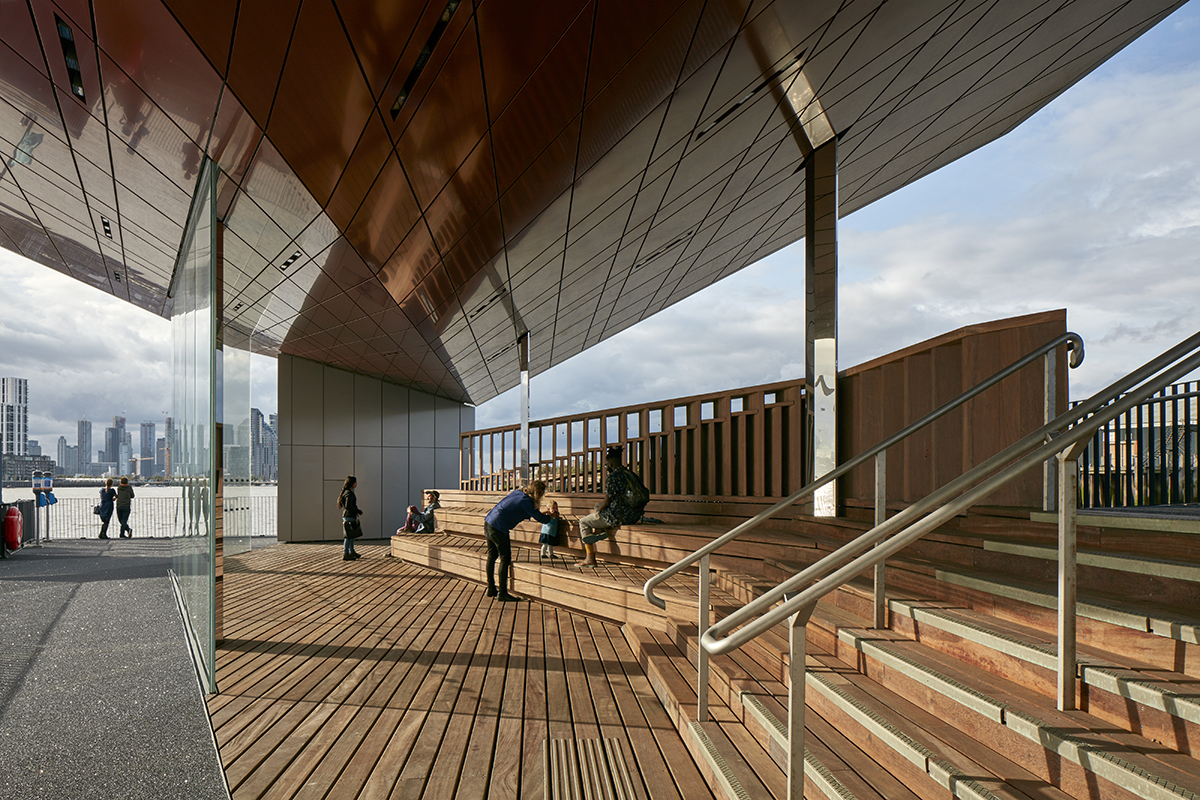Project showcase
Royal Wharf Pier

Royal Wharf Pier is a new riverboat terminal in Ballymore and Oxley’s Royal Wharf development in London’s Royal Docks, and at 130m long, incorporates London’s first floating public space on the Thames. The pier addresses the practical requirements of Thames Clippers while also providing a meaningful contribution to London’s riverside, with a public space that can be enjoyed by the community, Londoners and visitors alike.
The pier extends Royal Wharf’s public realm 40m into the Thames with a public promenade, a fixed element of the structure which is publicly accessible year-round. At the heart of the pier, a 162sqm viewing platform invites people to gather, providing bench seating and views through glass balustrades. With the latest wellness research from University of Greenwich demonstrating that Londoners who commute by boat are the happiest and most relaxed commuters, the pier promotes a healthier lifestyle through its purpose as a Thames Clippers terminal.
Who is the developer/client of the project?
Royal Docks, London
Describe the context and brief for this place?
Royal Wharf Pier is a new riverboat terminal in Ballymore and Oxley’s Royal Wharf development in London’s Royal Docks, and at 130m long, incorporates London’s first floating public space on the Thames. Joining forces with marine engineers Beckett Rankine in an innovative response to the site, the pier addresses the practical requirements of Thames Clippers’ traffic while also providing a meaningful contribution to London’s riverside, with a memorable public space that can be freely enjoyed by the community, Londoners and visitors alike. T he pier extends Royal Wharf’s public realm 40m into the Thames with a public promenade, a fixed element of the structure which is publicly accessible year- round.
T his linear open space is reminiscent of traditional British seaside piers, framing long, straight views towards the horiz on. At the heart of the pier, a generous 162sqm viewing platform invites people to gather, providing elegantly integrated bench seating and striking views through its unobstructed ultra- clear glass balustrades. Here, marine grade hardwood provides warm finishes to further enhance user experience, while carefully integrated, gentle lighting ensures a welcoming and safe public realm at all times. T he viewing platform also connects the promenade to the sheltered floating gangway and pontoon of the Thames Clippers terminal, where an enclosed waiting area offers warmth and protection from the elements. With a large glass façade to allow a good overview of incoming river traffic, the shelter’s playful form features a cut back roof line which slopes down towards the water, taking advantage of impressive views down the river.
How has this project or intervention contributed to the urban life or user experience of this place?
Reminiscent of traditional British seaside piers, the pier brings together public space and infrastructure, in an economically viable, yet high quality social space for everyone, offering a long- term, positive contribution to its riverside setting. The completion of Royal Wharf Pier sees the extension of the Thames Clippers service to the Royal Docks. In turn ,the wider community benefits from improved connectivity, with a viable new public transport option in the area offering easy access to other parts of London. The pier’s role in this new service also offers tourists and commuters with a new alternative to get in and out of central London as the capital looks to diversify its transport infrastructure.
T his offers an invaluable contribution to regeneration in the Royal Docks, not only as a more attractive location for commuters but also in increasing visits to the area and increasing footfall to local businesses. Being only 15 mins walk from nearby City Airport, the pier is also a new gateway to central London for arriving visitors. Looking at the practicalities of riverboat services, Nex’s design development of the riverboat terminal was based on feedback from stakeholders and existing commuters to ensure that the design adds a meaningful, advancement and long- term contribution to the service.
What do you see as the greatest success of this project?
Contributing to Royal Wharf and London’s riverside, the pier addresses the practical requirements of the Thames Clippers service while providing a memorable new public space for all. T he pier extends Royal Wharf’s riverside public realm with a promenade and viewing platform. Open to the public year- round, this welcoming public space is free and easily- accessible to everyone, encouraging social interaction between the local community, Londoners and visitors alike. T he pier’s built- in seating and shelter offers a peace fullspace that invites people to linger and admire the unique views of the Thames, while spending more time enjoying the outdoors, and the sense of well- being that this offers. With the latest wellness research from University of Greenwich demonstrating that Londoners who commute by boatare the happiest and most relaxed commuters, the pier also promotes a healthier lifestyle through its purpose as a Thames Clippers terminal.
Finally, the 130m long pier – the longest on the Thames - is an example of successful architectural and engineering innovation, and procurement. T he structure was fully designed in BIM, manufactured in 6 individual parts using ship-building methods in the Netherlands and delivered to London by barge. T his enabled a fast track construction programme and minimal disruption on site, with manufacture to completion in October taking 8 months, and on- site installation only taking 5 weeks. Despite being located across Europe, a rigorous design collaboration between all parties ensured that a project which demanded millimetre precision, could be delivered on time, under budget and to the highest quality.
Please share any figures that support your entry – for example, increased dwell time, happiness surveys, footfall, event attendance, or observed changes in behaviour. Article references or quotes from supporters or reviews in the media may also be included.
‘A scheme which can encourage more water transportation with an elegant, pragmatic piece of design ’New London Architecture Jury Citation. New London Architecture Award for Best new Infrastructure (unbuilt) 2019“...Our conversation has broadly been about the privatisation of public space – but Dempsey’s interpretation is more nuanced than mine. Public space bylaws abound, he says; for him the bigger question concerns the terms under which you can use it and how private space can embody a civic, public component. He answered the question at Royal Wharf Pier in London’s Docklands by creating a public river walk on the way to his riverboat pontoon for Ballymore – a jetty projecting 130m into the Thames with the surprise of a glazedbalus trade around a triangular pier that allows the public to get up close and personal with the rise and fall of the river.” Jan- Carlos Kucharek RIBA Journal Dec 2019.
Festival of Pineapples
24-26 February 2026
Pineapples prize giving night
April
Pineapples at Festival of Place
10 June 2026
© The Pineapples - Tweak Ltd. 124 City Road, London, EC1V 2NX. Tel: 020 3326 7238




